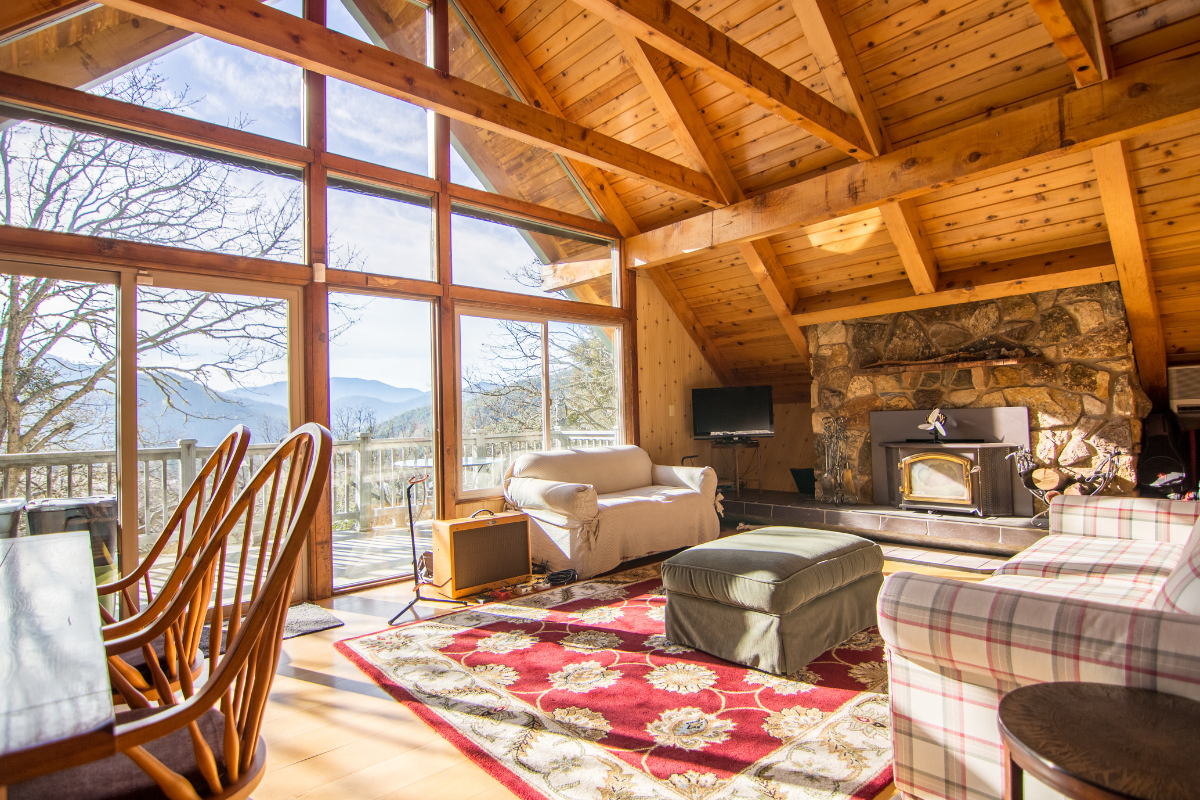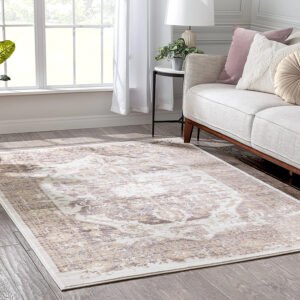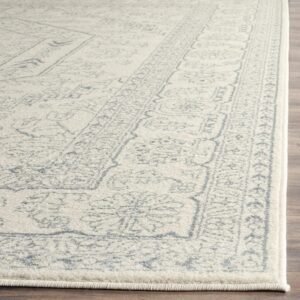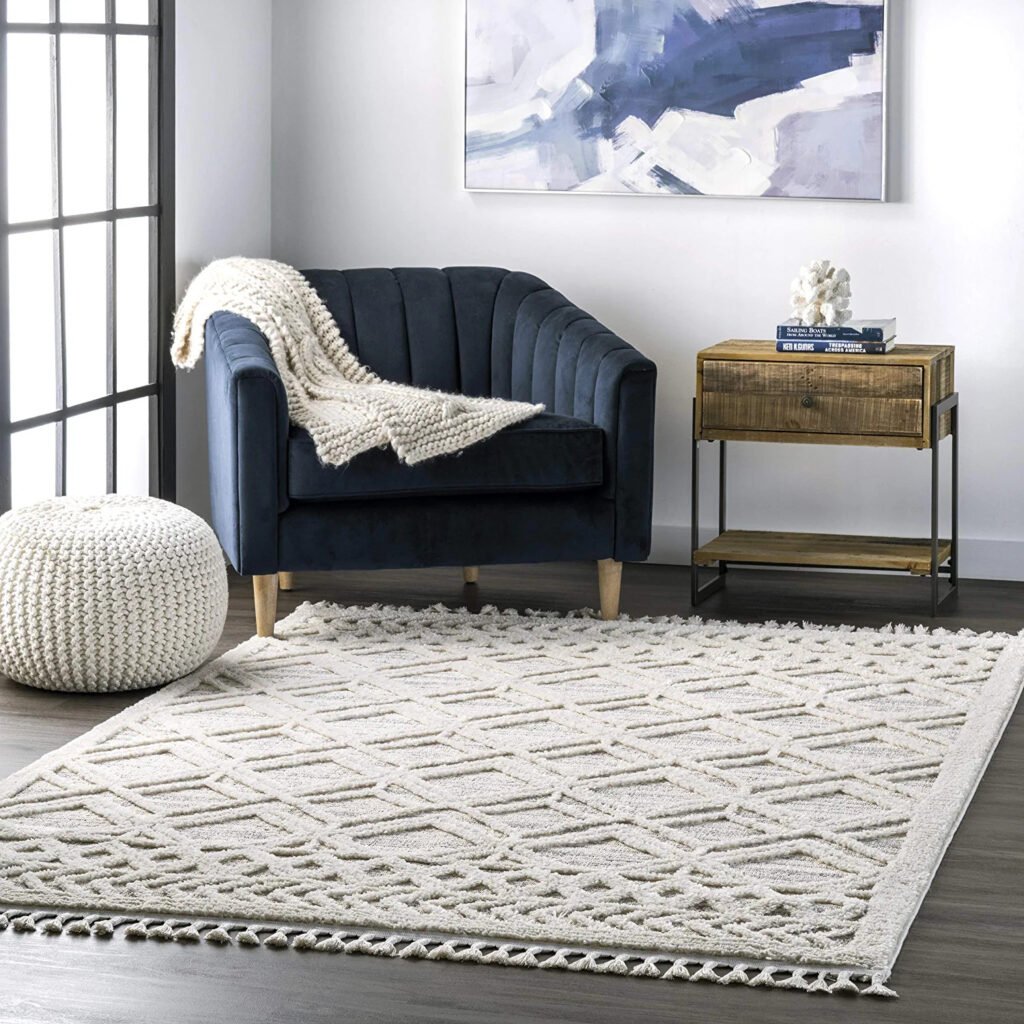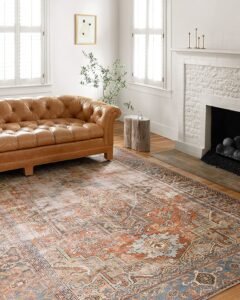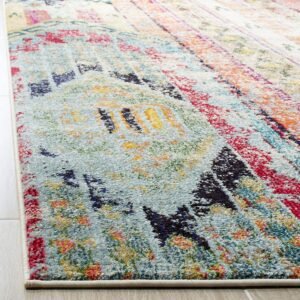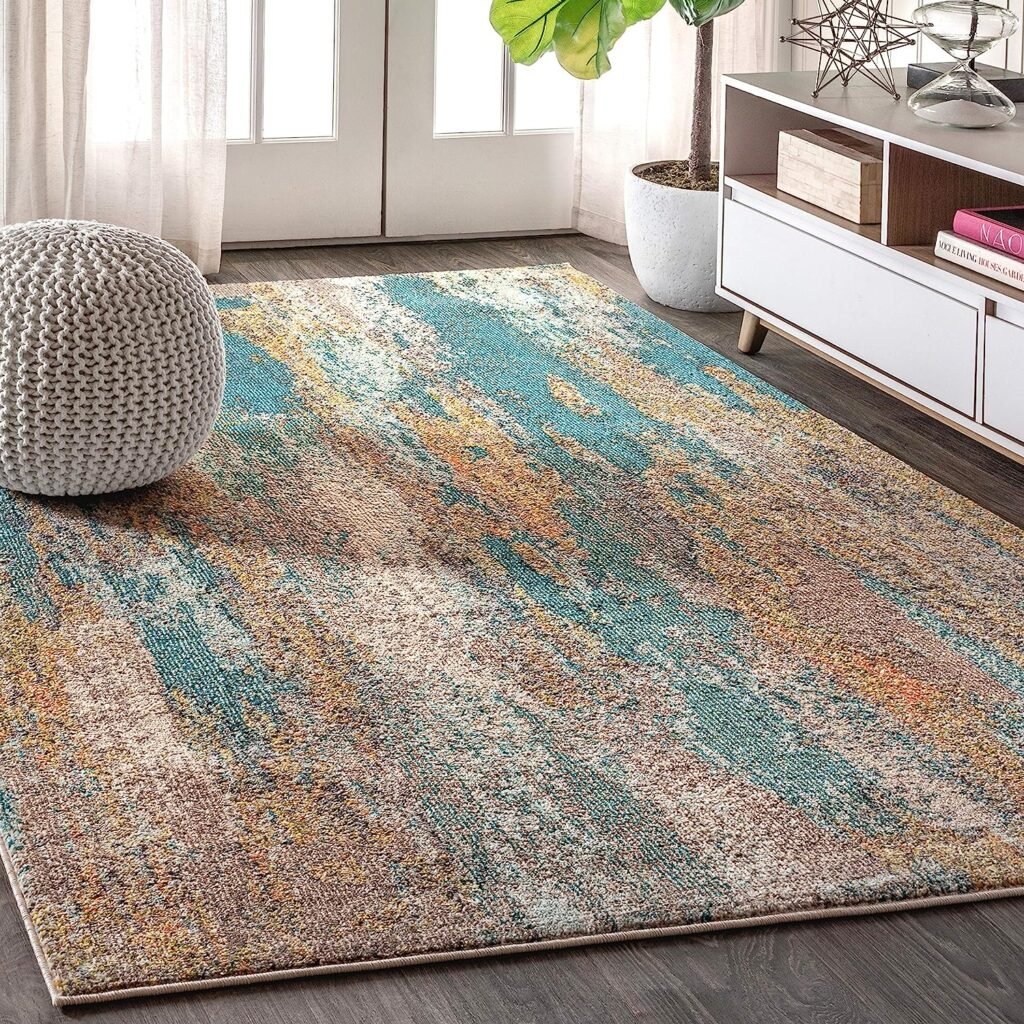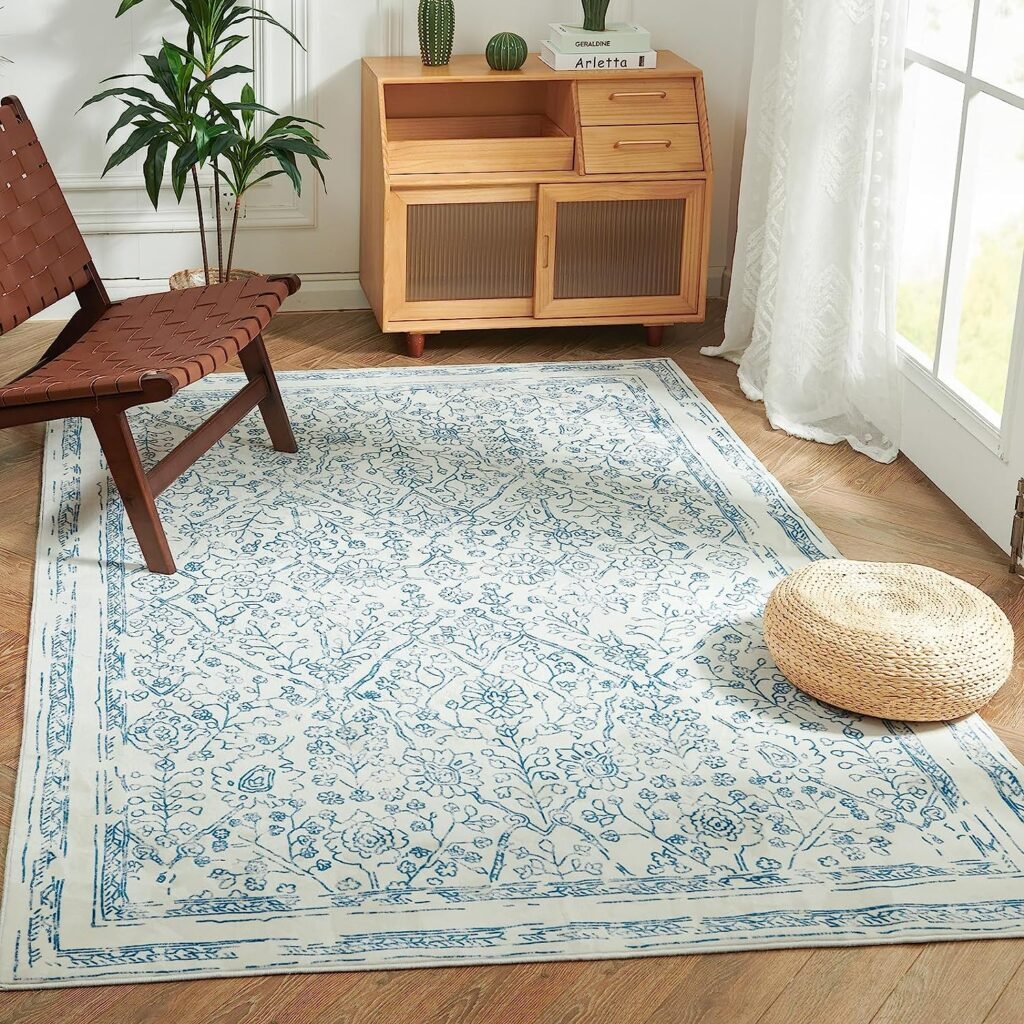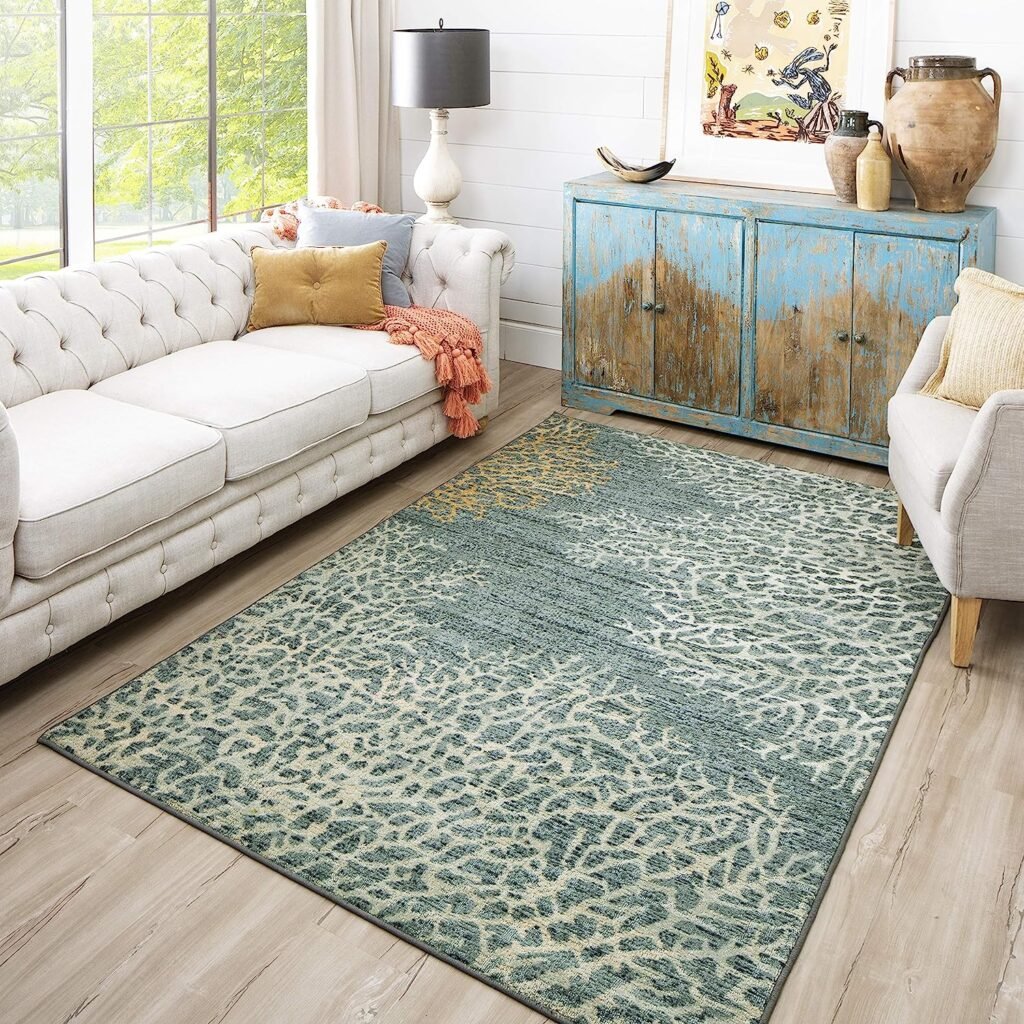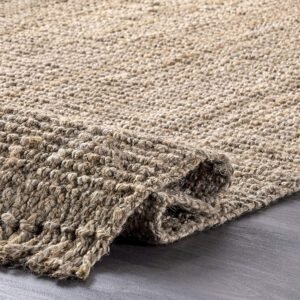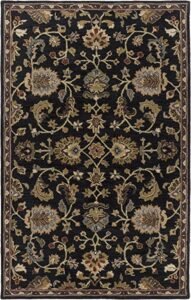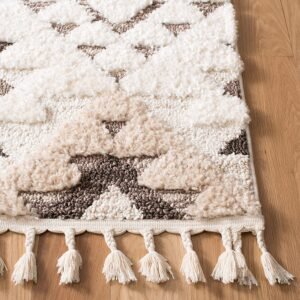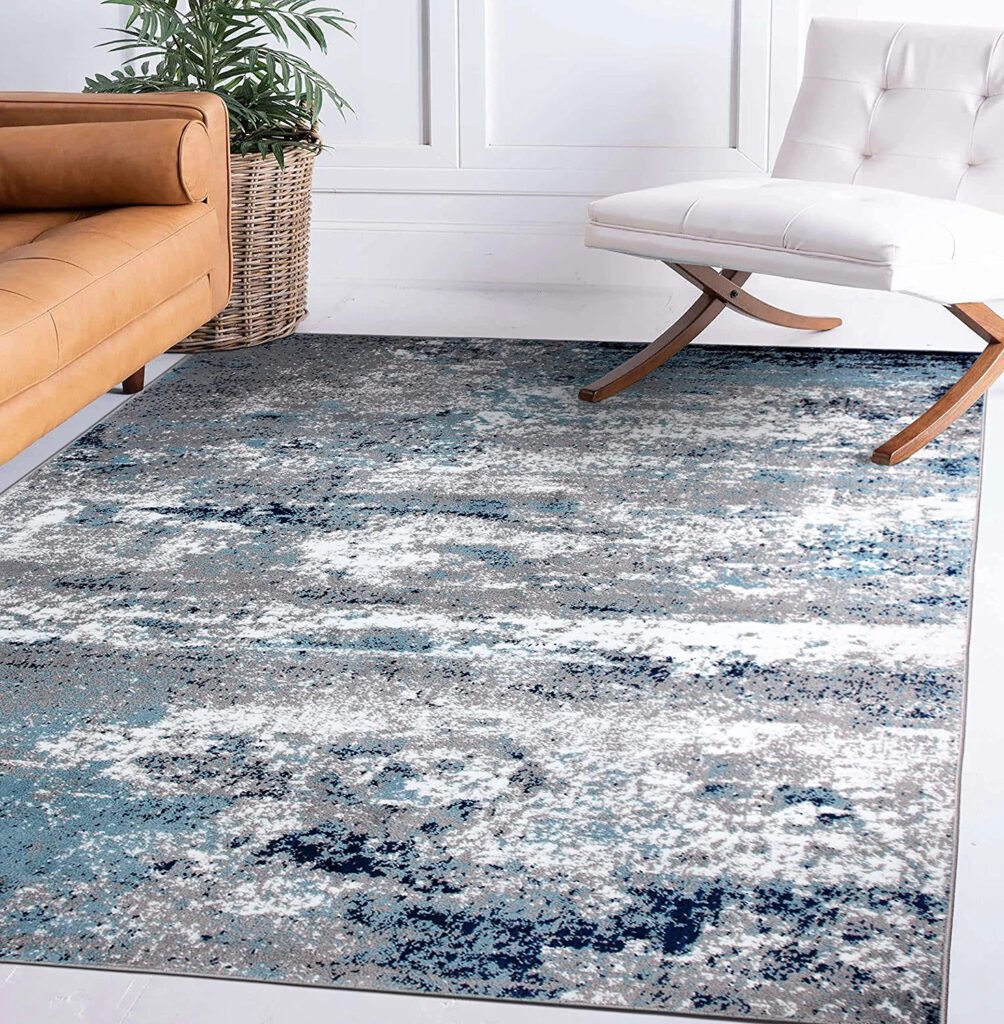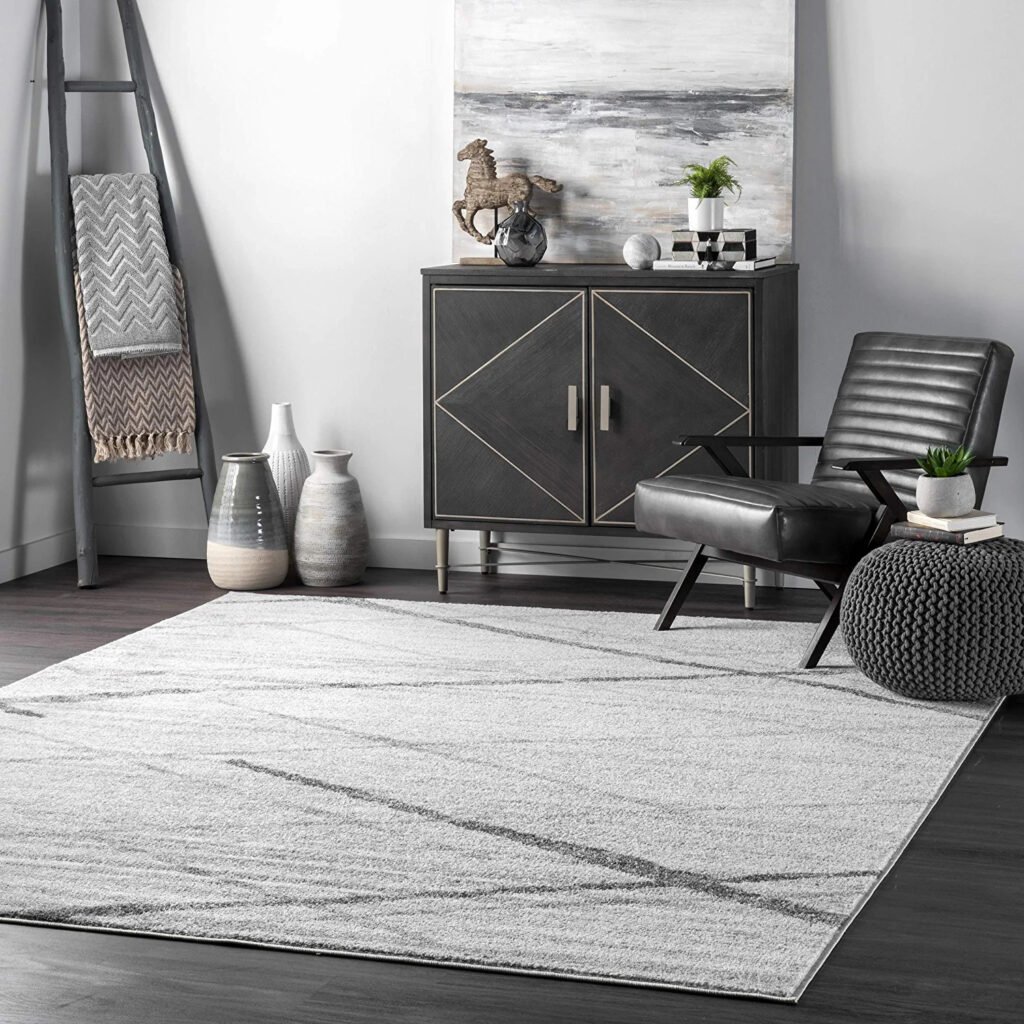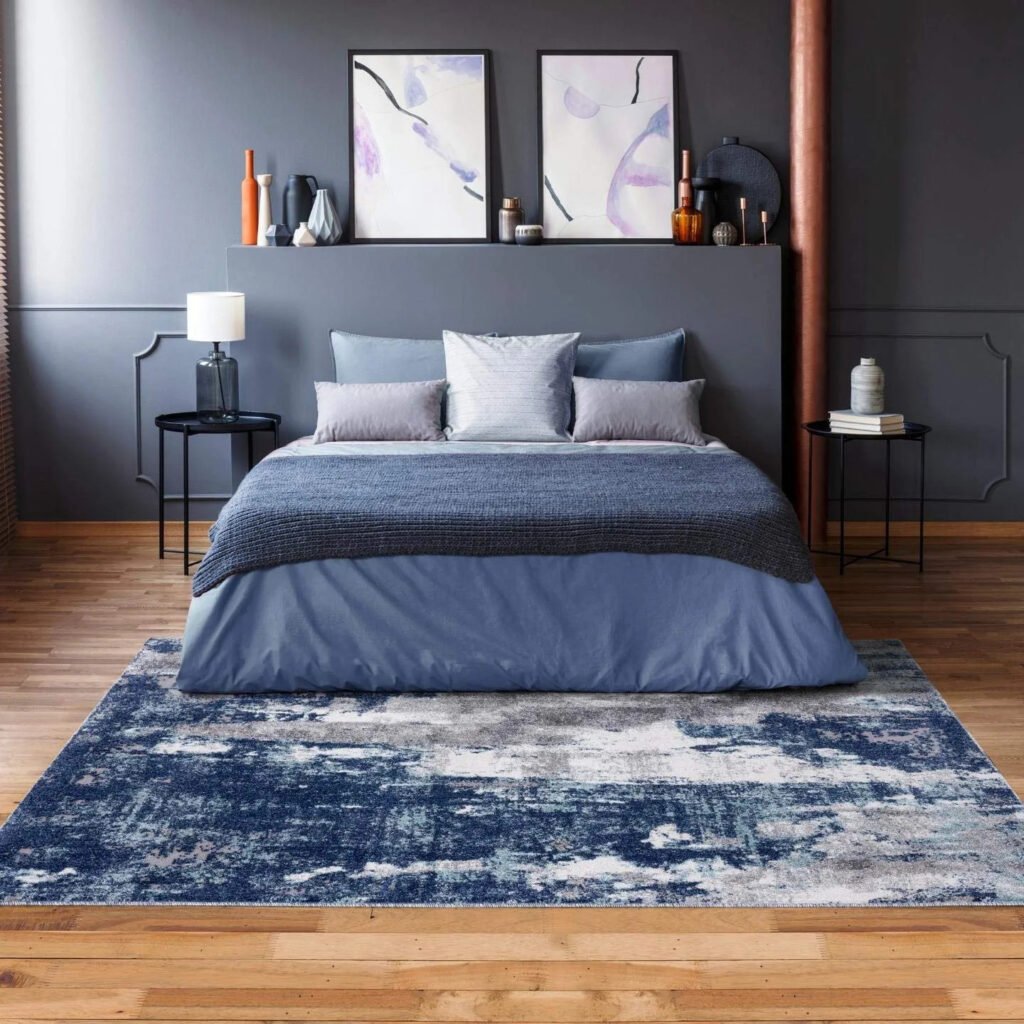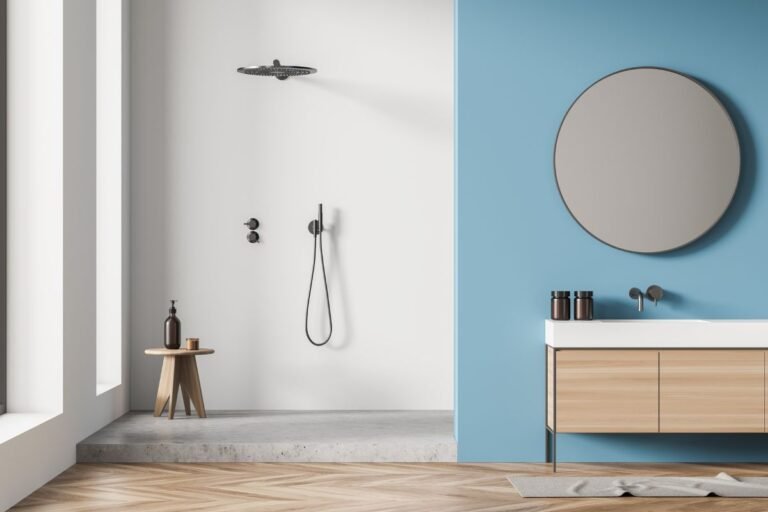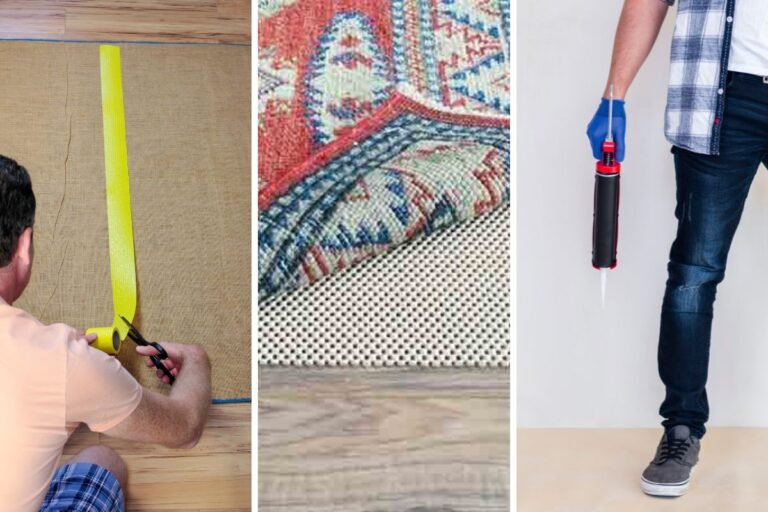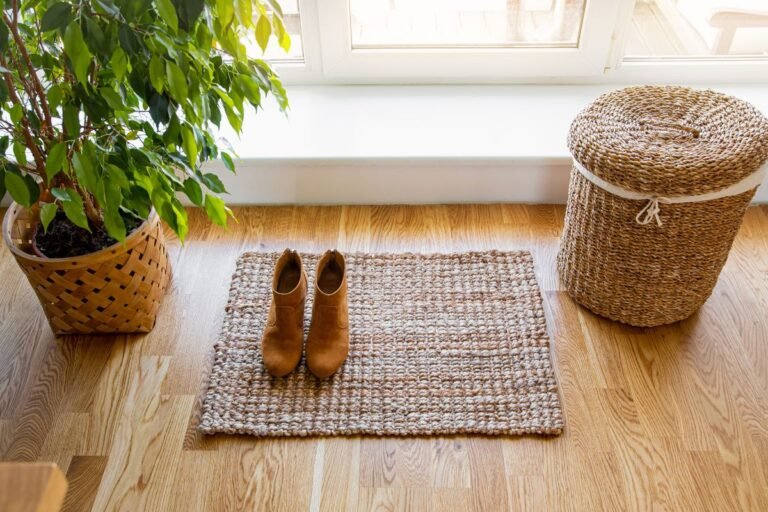I LOVE the process of choosing an area rug… there is so much potential! I don’t know about you, but I feel like a kid in a candy shop. It’s hard to know where to begin!
Luckily, there is a sort of rug style guide. So I put all the little decorative tips and rules when it comes to choosing the perfect rug color to make the process a little easier for you.
Here’s how to choose a rug color that will bring your room together.
Step 1: Understand Your Room’s Vibe
When it comes to choosing the color of your rug, the vibe or feel of your room plays a significant role. The right rug color can either enhance or alter the mood of your space, so it’s helpful to understand what vibe you’re aiming for.
For instance, if you’re going for a serene and calming atmosphere, such as in a bedroom or a reading nook, you might want to consider cooler hues like blues, greens, or even a soft lavender. These colors are known to promote relaxation and tranquility.

If you want to create a lively and energetic vibe, like for a living room or an entertainment area, warmer tones such as reds, oranges, or yellows can be a great choice. These colors are known to stimulate conversation and activity.
Neutral colors like whites, grays, and beiges are versatile and can fit into almost any room vibe. They can either create a minimalist, modern feel or serve as a balanced backdrop for other vibrant pieces in your room.
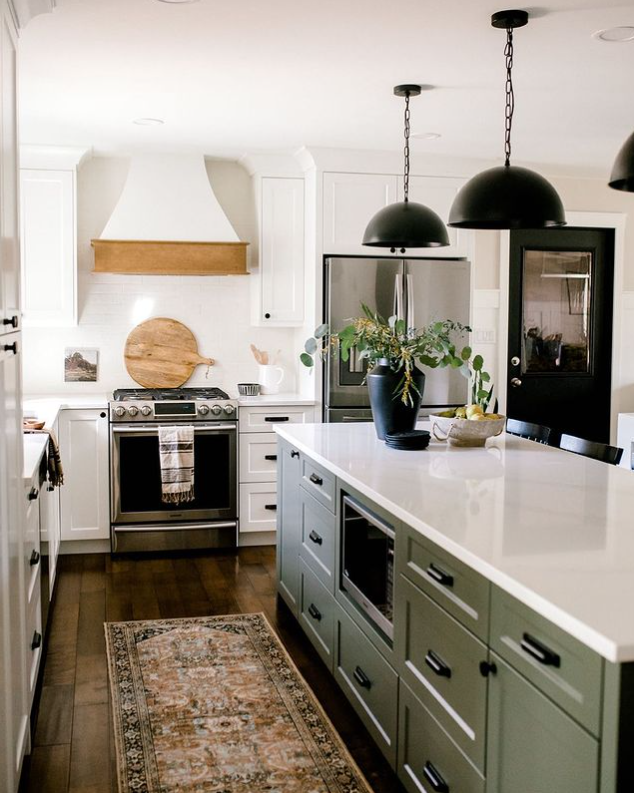
In terms of current home décor trends, earth tones are making a big comeback. Colors like burnt orange, deep blues, and olive greens are not only trendy but also create a warm, cozy and inviting atmosphere too. These colors work well in spaces where you want to create a cozy and comfortable vibe.
Another trend is the use of bold, vibrant, and bright colors in rugs to create a statement piece in the room. This works well in a room with neutral walls and furniture, where the area rug becomes the focal point and adds a pop of color.
Don’t stress too much, the rug color should not only match your room’s vibe but also your personal style. After all, your space should be a reflection of you! So, don’t be afraid to experiment with different colors until you find the one that feels just right.
Step 2: Choose a Theme for Your Room
Choosing a theme for your room is like setting the stage for a play. It’s the backdrop against which all your furniture, accessories, and of course, area rugs, will shine. A well-chosen theme can tie together disparate elements, create harmony, and express your personal style. And when it comes to choosing a rug color, your room’s theme can be your guiding star. ⭐
Modern Minimalist
The modern minimalist theme is all about simplicity, functionality, and clean lines. The color palette is usually neutral, with shades of white, gray, and black taking center stage. For this theme, you might want to choose an area rug in a solid color or with a subtle geometric pattern. A monochrome rug in black, white, or gray can add depth and interest without disrupting the minimalist aesthetic.
Throw pillows in solid colors or with subtle geometric patterns can add a touch of comfort without overwhelming the space. Opt for wall colors in shades of white or light gray to maintain a clean, uncluttered look. Other accents, like a sleek metal lamp or a simple black and white print, can add interest without disrupting the minimalist aesthetic.
Bohemian Chic
Bohemian chic is a vibrant and eclectic theme that embraces a mix of colors, patterns, and textures. It’s inspired by the free-spirited and artistic bohemian lifestyle. For a Boho-themed room, don’t be afraid to choose an area rug with bold colors and exotic patterns. A Persian or Moroccan rug with intricate designs can be a stunning centerpiece in a Bohemian room.
Throw pillows in a variety of colors, patterns, and textures can add depth and interest to your space. Don’t be afraid to mix and match – the boho aesthetic is all about eclectic charm. For wall colors, consider warm earth tones or vibrant hues that reflect your personality. Other accents, like a vintage mirror or a colorful tapestry, can add a touch of bohemian flair.
Coastal Calm
The coastal theme is inspired by the sea and the beach. It features a palette of cool colors, like blues, sandy beiges, and crisp whites, evoking a sense of calm and relaxation. For a coastal-themed room, consider an area rug in a light, breezy color like sand or seafoam. A striped or nautical pattern can also enhance the beachy vibe.
Throw pillows in shades of blue, white, or sandy beige can enhance the beachy vibe. Consider wall colors in light, airy hues like seafoam green or sky blue. Other accents, like a seashell collection or a piece of driftwood, can bring a touch of the sea into your home.
Rustic Farmhouse
The rustic farmhouse theme is characterized by its warm, homely, and nature-inspired elements. It often features a palette of earthy tones, like browns, creams, and greens. For this theme, an area rug in a warm, earthy color or a classic plaid or gingham pattern can add a touch of coziness and charm. Vintage rugs add a great rustic touch.
Throw pillows in earthy tones or classic patterns like plaid or gingham can add a touch of homely charm. Consider wall colors in warm, neutral colors like cream or taupe. Other accents, like a vintage wooden clock or a barn-style picture frame, can enhance the rustic farmhouse aesthetic.
Step 3: Factor Furniture in Rug Color Selection
If you’re aiming for a cozy, intimate atmosphere, a rug that’s darker than your furniture can help make this happen. Darker area rugs tend to make a room feel smaller and more enclosed, which can be perfect for creating a snug living area or a cozy reading nook.

If you’re looking to make your space feel larger and more open, a lighter rug is the way to go. Lighter colors reflect more light, which can help to make a room feel more spacious. This can be particularly beneficial in smaller rooms or spaces with limited natural light.
But what if your furniture is a mix of light and dark? In this case, a mid-tone rug can be a great choice. It can provide a bridge between the lighter and darker pieces, tying everything together and creating a harmonious look.
When it comes to picking a rug color that complements your existing furniture and interior design, there are a few key factors to consider:
- Contrast: If your furniture is a solid color, a rug with a contrasting color or pattern can add interest and depth to your space.
- Coordination: If your furniture features a pattern or print, try to pick out one color from the design and find a rug in that color. This will help to tie your room together without making it look too busy.
- Mood: Different colors can evoke different moods. For example, blues and greens can create a calm, relaxing atmosphere, while reds and oranges can add warmth and energy. Consider the mood you want to create in your room when choosing your rug color.
Step 4: Choose Lighter vs Darker Rug Colors
When it comes to choosing a rug color, it’s not just about personal preference. The color of your rug can significantly impact the overall feel of your room.
Lighter Rug Colors
Lighter rug colors can help create a sense of spaciousness and brightness in a room. They reflect light, making the room appear larger and more open. This makes them an excellent choice for smaller rooms or spaces with limited natural light. However, lighter rugs might show stains and dirt more easily, so they might require more frequent cleaning, especially in high-traffic areas like the living room or entryway.
Darker Rug Colors
Darker rugs can add depth and warmth to a room. They’re great for creating a cozy, intimate atmosphere. Plus, they’re more forgiving when it comes to stains and dirt, making them a practical choice for busy households or pet owners. But be careful, as too much dark color can make a room feel smaller or overly heavy.
Should a Rug Match or Contrast the Floor?
Now, should your rug match or contrast your floor? Well, it depends on the effect you’re aiming for. If you want to create a seamless, flowing look, you might choose a rug that closely matches your floor color. This can help make your room look larger and more cohesive.
However, if you’re looking to add a pop of color or define a specific area in your room, a contrasting rug could be the way to go. For instance, a dark rug on a light floor can ground the space and draw attention to the center of the room. Similarly, a light rug on a dark floor can provide a striking contrast and make your rug the focal point of the room.
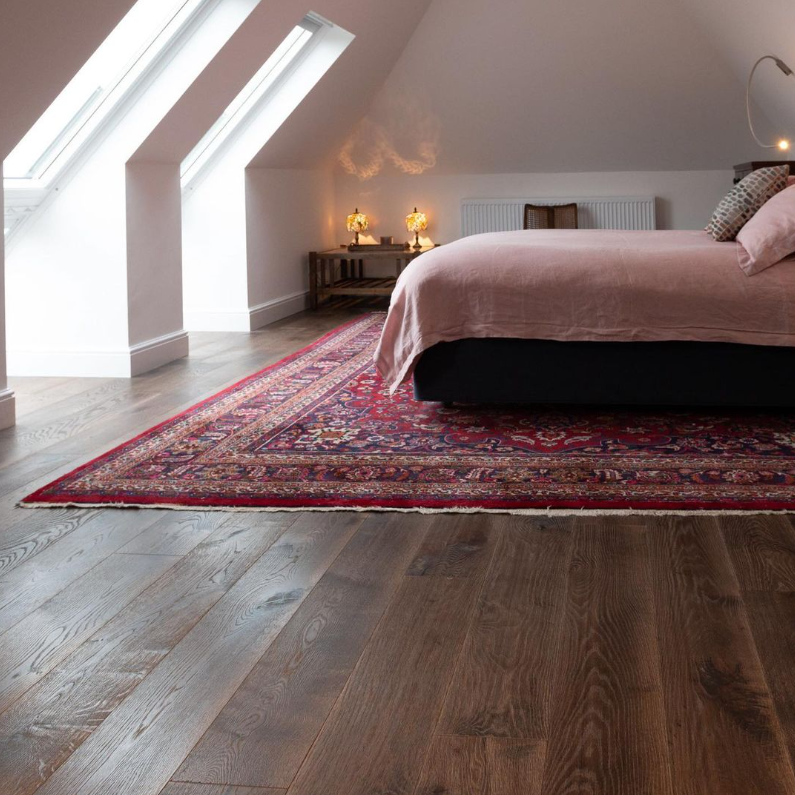
Step 5: Choose Rug Styles and Patterns
There are so many rug patterns and choosing the right one can help you reinforce the vibe and theme you are after. Here’s how to find the right rug patterns for your theme.
- Traditional Rugs: Traditional rugs often feature intricate designs and rich, warm colors. Think deep reds, blues, and golds. These rugs can add a touch of elegance and sophistication to any room. If you’re considering a traditional rug, you might want to stick with classic, deep colors that complement the rug’s intricate design.
- Contemporary Rugs: Contemporary rugs are known for their bold, abstract patterns and use of vibrant colors. If you’re leaning towards a contemporary rug, you have the freedom to play with a wide range of colors. From bold blues to vibrant yellows, the color choice is yours. Just remember to choose a color that complements the rest of your room’s décor.
- Geometric Rugs: Geometric rugs feature bold, geometric patterns that can add a modern touch to any room. These rugs often use contrasting colors to make the geometric rug patterns really stand out. If you’re considering a geometric rug, you might want to choose a color that contrasts with your floor to make the rug’s pattern pop.
- Floral Rugs: Floral rugs are a great way to bring a touch of nature into your home. These rugs often feature soft, pastel colors that can add a calming, serene feel to any room. If you’re considering a floral rug, you might want to stick with soft, pastel colors that complement the rug’s floral design.
- Solid Rugs: Solid rugs are a great choice if you want to keep things simple. These rugs can add a touch of color to any room without overwhelming the space. If you’re considering a solid rug, you have the freedom to choose any color you like. Just remember to choose a color that complements the rest of your room’s decor.
Step 6: Consider Rug Sizes and Their Impact on Color Choice
When it comes to choosing the perfect rug for your space, size matters – and not just for fitting it into your room. The size of your rug can significantly influence the color choice, and here’s why.
The Illusion of Space
Firstly, rug size can create an illusion of space. Larger rugs in light colors can make a room appear more spacious, while smaller rugs in darker shades can make the space feel cozier and more intimate. So, if you’re working with a small room, you might want to consider a large, light-colored rug to open up the space. On the flip side, a smaller, darker rug can add warmth and coziness to a large, airy room.
The Balance of Color
A large rug with a bold color or pattern can become the focal point of the room, allowing you to keep other decorative accents more neutral. However, if your rug is smaller, you might want to opt for a more subtle color or pattern to prevent it from getting lost among other furnishings.
The Practicality Factor
Larger rugs, especially in high-traffic areas, are more prone to visible stains and wear. Choosing a darker color or a patterned rug can help hide any accidental spills or dirt. Smaller rugs, on the other hand, are easier to clean and replace, so you can afford to be more adventurous with lighter colors.
Step 7: Rug Materials and Color Selection
Different materials not only have different textures and durability, but they also come in a variety of color options. Let’s explore some common rug materials and how they can impact your color selection.
- Wool Rugs: Wool is a classic rug material known for its softness, durability, and versatility. Wool rugs can be dyed in a wide range of colors, from vibrant hues to subtle pastels. This means you have a broad palette to choose from, making wool rugs a great choice if you’re looking for a specific color to match your décor.
- Cotton Rugs: Cotton rugs are another popular choice due to their affordability and ease of cleaning. While cotton rugs may not offer as wide a color range as wool rugs, they still come in a variety of appealing shades. Cotton rugs often feature more muted colors, making them a good choice for a room where you want the rug to blend in rather than stand out.
- Synthetic Rugs: Synthetic rugs, made from materials like nylon and polyester, are known for their durability and resistance to stains. These rugs can be produced in virtually any color you can imagine. If you’re looking for a rug in a very specific or unique color, a synthetic rug might be your best bet.
- Natural Fiber Rugs: Natural fiber rugs, such as jute or sisal, are appreciated for their organic look and texture. However, these rugs are typically available in neutral colors like beige, tan, or brown. If you’re aiming for a natural or minimalist aesthetic, these rugs can be a perfect fit.
Caring for Your Rug
Caring for your rug is just as important as choosing the right one. Different colors and materials require different care methods. Here’s a handy guide to help you keep your rugs looking fresh and vibrant.
Use A Rug Pad
A rug pad significantly extends the lifespan of your area rug by preventing premature wear. A rug pad acts as a protective layer between your area rug and the floor, reducing friction that can cause wear and tear over time. It also provides cushioning, which helps to absorb impact from foot traffic and heavy furniture, preventing damage to the rug fibers.
Clean Regularly
- Light-Colored Rugs: Light-colored rugs such as whites, creams, and pastels can brighten up a room, but they can also show dirt and stains more easily. Regular vacuuming is essential to prevent dirt from settling into the fibers. For spills, act quickly! Use a clean, damp cloth to blot – not rub – the spill. For tougher stains, consider using a mild rug cleaner, but always test it on a small, hidden area first. Check to see if you can put your rug in the washer for a deep clean.
- Dark-Colored Rugs: Dark-colored rugs are great for high-traffic areas as they can hide dirt and stains well. However, they can show lint, dust, and pet hair more than their light-colored counterparts. Regular vacuuming is also crucial for these area rugs. For dust and lint, a lint roller can be a handy tool.
- Natural Material Rugs: Rugs made from natural fibers and materials like wool or cotton are durable and eco-friendly. They require a bit more care to maintain their look and feel. Avoid direct sunlight, which can fade these rugs over time. Rotate your rug every few months to ensure even wear. For cleaning, use a mild, natural detergent and avoid harsh chemicals that can damage the fibers.
- Synthetic Rugs: Synthetic rugs, such as those made from nylon or polyester, are durable and often stain-resistant. They’re a good choice for areas prone to spills or heavy use. Most synthetic rugs can be cleaned with mild soap and water. Some can even be machine washed, but always check the care label first.
Frequently Asked Questions
How Do I Know What Color Rug To Get?
Choosing the color of your rug is a personal decision that should be influenced by your style and the existing décor in your room. Consider the color of your furniture, walls, and flooring. If your room is filled with neutral tones, a brightly colored rug can add a pop of color. If your room already has a lot of color, a neutral rug can help balance things out. Remember, your rug is an extension of your personality, so choose a color that you love!
Should Carpet Be Lighter Or Darker Than Furniture?
There’s no hard and fast rule about whether your carpet should be lighter or darker than your furniture. It all depends on the look you’re trying to achieve. If you want to create a cozy, intimate space, a darker carpet can help achieve this. A lighter carpet can make a room feel more spacious and airy.
Should An Area Rug Be Darker Than The Floor?
Again, this depends on your personal style and the look you’re going for. A darker rug can provide a striking contrast against a light floor, making it a focal point of the room. Conversely, a lighter rug on a dark flooring can create an interesting visual effect.
Should Rug Match Or Contrast The Floor?
Whether your rug should match or contrast with your floor depends on the effect you want to create. If you want your rug to blend in with your flooring and not draw attention, go for a matching color. If you want your rug to stand out and make a statement, choose a color that contrasts with your floor.

